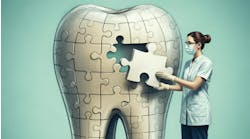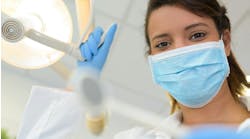by Kevin Henry, Managing Editor
The day dawned gray and rainy in New York City. Commuters huddled under their umbrellas as they made their ways from the subway to their offices. Street vendors hawked their goods, and the occasional tourist even stopped to take a few pictures of the giant advertisements that surround Times Square.
Amidst all of the hubbub that is Manhattan, and all of the flashing, glowing, moving signs that comprise the Times Square area, dignitaries from the dental industry and various dental associations gathered early on Feb. 6, 2004, to kick off the ADA's Give Kids A Smile Day. While it was gloomy outside, one couldn't help but feel a sense of excitement within the room.
"Give Kids A Smile is a compelling and inspiring demonstration of what can be achieved when everyone is brought together for a common goal," said Dr. Louis Sullivan, former U.S. Secretary of Health and Human Services. "Today throughout our country, diverse groups are coming together to help those who need it the most."
As proof of the power of the day, Dr. Sullivan joined other dignitaries to help open the day of trading on Nasdaq. Sullivan-Schein Dental, one of the sponsors of GKAS, is a Nasdaq member.
"Organized dentistry views this as an important program," said Stanley Bergman, chairman, chief executive officer, and president of Henry Schein. "It's something all of us view as a solution to the beginning of dealing with the disparity of the health care issue in America. We believe that Give Kids A Smile is proof that Benjamin Franklin was absolutely right more than two centuries ago when he conceived his philosophy of enlightened self-interest — you can do well by doing good."
"Little Orphan Annie once said that you're never fully dressed without a smile," Dr. Richard Haught, the president-elect of the American Dental Association, told the crowd as the clock ticked down toward the opening of the Nasdaq market. "Today, we are all demonstrating our belief in the future of our country."
Give Kids A Smile, a nationwide event sponsored by Sullivan-Schein Dental, Crest Healthy Smiles 2010, DEXIS, and Ivoclar Vivadent, saw an estimated 14,000 dentists and 21,000 auxiliaries in 2,000 locations throughout the United States reach out to more than 1 million children using $2.25 million of donated goods. Those are mind-boggling numbers to say the least, so Dental Economics has decided to break it down into smaller pieces. We talked to dentists from coast to coast about their experiences on that day, what they found in the mouths of their young patients, and the impact that this one day had on them. We hope you enjoy reading some of their stories.
St. Louis, MO
The roots of Give Kids A Smile can be traced back to the Gateway City. In.August of 2001, Dr. Jeff Dalin watched as 200 underprivileged children came to a "Back to School" shopping spree. While these kids were treated like royalty and given everything from new clothes to school accessories, their siblings and parents were given some dental education by Dr. Dalin.
"I was on the local committee for access and we were trying to figure out how we could reach kids and help them with their dental needs," recalled Dr. Dalin, who is a regular columnist for Dental Economics. "I told everyone about this outreach and we decided we could do the same thing with a dental theme."
In February of 2002, Give Kids A Smile was born in St. Louis. Dr. Dalin saw that the program was a hit in his city, so why not take the program nationwide?
The rest, as they say, is history. The idea was presented to the ADA board of directors and quickly passed. The ADA's first nationwide GKAS.Day happened in 2003, and Dr. Dalin and his cohorts again played a big role in St. Louis during the second nationwide effort this past February — the fifth GKAS event in St. Louis (two days of GKAS are conducted every February and October). Held at the Saint Louis University Center for Advanced Dental Education, a total of 1,202 X-rays, 531 prophies, 488 fluoride treatments, 601 restorations, 31 pulpotomies, 181 extractions, 348 sealants, 12 root canals, and 13 chromesteel crowns were completed in.February.
"We call this a 'blitz clinic.' There are a lot of kids and we get them through as fast as we can. This program has a lot of impact on the kids, parents, and dentists who take part," Dr. Dalin said. "Dentists never get the chance to work with each other. This program lets them do that while helping out needy kids. Once you participate in this program, you're hooked."
Does it seem possible to Dr..Dalin that an idea he helped to start is now impacting more than 1 million children per year?
"It really sends chills up your back," he said. "We know dentists around the country give their time to help people. We always thought it would be great to have everyone doing the same thing on the same day under the same banner. Now it's a reality and it's a great thing."
Yukon, OK
While the Give Kids A Smile idea was groundbreaking, the thought of helping children in his community was nothing new to Dr. David Deason. Dr. Deason and other dentists in Yukon, Okla., have been reaching out to local schools for 30 years, targeting first-, second-, and third-graders with in-school screenings and talks during February, which is National Children's Dental Health Month.
Dental professionals used 58 chairs at the Saint Louis University Center for Advanced Dental Education during GKAS Day.
Over the course of those 30 years, Dr. Deason estimates that more than 17,000 children have been impacted through the program. It's become an annual rite of passage for many children in the Yukon School System.
"We've found that the teachers talk to the kids about us and dentistry before we come in to visit. We've also found that the kids know the answers to the questions we ask before we even ask them," Dr. Deason laughed. "It's rewarding to me to see those teachers taking an interest in their student's oral health."
Through a group called "Helping Hands," Dr. Deason and other Yukon dentists are called when a student is in need of dental help.
"These 'Helping Hands' are ladies who are employed by the school system to help classes, whether it's getting volunteers to help with test-taking or getting information about when certain events will be taking place," Dr. Deason explained. "During Give Kids A Smile, Helping Hands set up a grid with 30-minute increments for 11 Yukon dentists to see kids all day on that Friday. We quickly filled every slot."
Dr. Deason estimates roughly 70 Yukon children were seen on Give Kids A Smile Day. Several "special assistants" — such as Yukon's mayor, a state representative, and a district judge — donned masks and saw first-hand some of the challenges faced by Dr. Deason and his cohorts. The problems seen in children were as varied as Yukon's demographic patterns.
Dr. David Deason and Gina Wedman screen kids at Skyview Elementary in Yukon, Okla.
"We wanted to get dignitaries involved with the day so more attention could be called to the event in the future," Dr. Deason explained. "As a suburb of Oklahoma City, we have some residents who have good jobs and commute back and forth to Oklahoma City. We also have some schools that are mostly comprised of children from lower-income families. We really saw a mixed bag, but not a lot of surprises. The kids from the upper classes had sealants while the kids whose parents weren't as well off financially had problems."
Dr. Deason described two of those children who had problems as having "bombed-out" mouths. However, he was also pleased to say that both had been scheduled for follow-up appointments and were being treated.
"That's very rewarding," Dr. Deason said. "It's also very rewarding for me to see the camaraderie among the dentists in this community. We may not all agree with each other's treatment plan, but we are all still able to work together toward a common goal — helping kids. I know we are filling a bit of a void, and that's a good feeling."
Dr. Deason sees Give Kids A Smile as a natural extension of the annual program he has been a part of for 30 years. He also believes that school-based programs can be started anywhere in the country.
"I believe that every community could have a program likes ours. It's great for us to have Helping Hands, but schools that don't have someone like that could have the PTA or other volunteers involved," Dr. Deason said. "It doesn't take much time to organize. All it takes is finding a school and finding a way to get letters out to the parents and guardians."
For ideas on how to start a program in your community, Dr. Deason can be contacted at his office at (405) 354-4802.
New York City/Long Island
When Dr. Peter Blauzvern saw the weather forecast, he admits he got a little nervous. A mix of rain, freezing rain, and snow was supposed to hit on Friday, meaning it might be troublesome for the buses full of children to reach the Long Island Marriott. Hotel ballrooms had been transformed into makeshift examination rooms. Where black-tie dinners had been held in the past, a television now sat, prepared to play cartoons emphasizing the importance of brushing and taking care of your teeth.
But would the weather cooperate? Dr. Blauzvern watched the thermometer as it hovered above the freezing mark all day U and watched as busload after busload of children came through the Marriott hallways toward the rooms set aside for Give Kids A Smile.
"I think we exceeded our expectations today," said a tired but happy Dr. Blauzvern. "The weather held off. Everyone showed up. We had a bunch of wonderful volunteers and a great site provided by the Marriott. It was great."
Dr. Blauzvern, president of the Nassau County Dental Society, estimated more than 500 kids were seen by more than 60 dental professionals during the first GKAS event held in Nassau County.
"We're here to get these kids — and parents — going in the right direction when it comes to oral health," Dr. Blauzvern said. "It wasn't hard to find people to volunteer for this day."
Were there any kids who were a little nervous about seeing the dentist?
"Sure, but once they saw some people doing magic tricks and serving cookies and punch, I think they got over it pretty quickly," Dr. Blauzvern smiled.
Across the East River at New York University, it was hard to tell if there was any apprehension in the air. Guitar players strummed sing-a-longs, some children concentrated on their coloring pages while others remained motionless as their faces were painted, and Spiderman even made a brief appearance.
Children in Nassau.County (N.Y.) practice their brushing techniques.
While it was all fun in the waiting room, plenty of residents were working in the operatories of NYU's dental school, examining patients and seeing what could be done to improve their oral health.
"A lot of these kids have parents who have rarely seen a dentist, and that child is going to learn from that," said Dr. Jeannine Weiss, a faculty member at NYU who is double-trained as a pediatric dentist and an anesthesiologist. "Our job is to fix some of those mistakes and try to have these kids learn about going to the dentist and taking care of their teeth. We want them to know that dentists aren't the threat; not taking care of your teeth is."
Warren, MI
Dr. Chuck Marinelli has seen a lot of patients over the last two years of working with Give Kids A Smile, but this year provided him with a young patient he will never forget.
A 16-year-old young man was brought to the clinic by his grandmother for help. As it turned out, the boy's needs went beyond just oral hygiene.
"This was a young man who came from a broken home and had lived with his father, mother, and now grandmother. He had dropped out of school because his upper teeth (numbers 6-10) were just nubs," Dr. Marinelli said. "Kids can be brutal at that age, and this young man had dropped out of school partly because his teeth were in such bad shape."
Dr. Marinelli was one of several dental professionals who assisted in starting to put this young man's life back together on GKAS Day, the second consecutive year that GKAS was coordinated and hosted by Dr. John Buchheister and his staff. Before the day was over, the young man had had a quadrant of amalgams, four root canals (performed by an endodontist), posts and cores, and the teeth were prepped for crowns.
He was one of an estimated 120 children, ranging from 3- to 16-years-old, who were seen on GKAS Day. Ten dentists, including Dr. Marinelli, worked from 9 a.m. until 8 p.m., giving everything from X-rays to sealants and fillings.
"We probably worked the hardest on the younger ones because we felt like we could really make an impact with them," Dr. Marinelli said. "We figured that if we had the kids in here, we wanted to get the job done. We didn't want to just examine them and send them home. We wanted to get the most bang for the buck while we had them sitting in our chairs."
While Dr. Marinelli is happy with the work that was done that day in Warren — a place he describes as "blue-collar America" — he knows there is still a long battle ahead for dental professionals in the area.
"The programs are there to help these kids, but the parents just aren't taking the time to take the kids to the dentist,".he explained. "It's disheartening to bust your butt to help a kid, then see him or her six months later and all of your work has been destroyed and you almost have to start over. It's just a lack of education, and something has to be done about it."
But however disheartened Dr. Marinelli may be, he won't forget the 16-year-old boy who can now start putting his life back together. He will also remember that when the young man walked into the waiting room and his grandmother saw him, she started to cry.
"He told us that he was going to get back into alternative school," Dr. Marinelli said. "We told him that when he's older, he has to help out a kid. I really feel like we are losing a generation of contributors to charities, and I want this young man to remember what happened to him so hopefully he can help out someone else."
Phoenix, AZ
Helping out underprivileged kids is nothing new for Dr. Greg Pafford. Five years ago, the Phoenix dentist built a dental clinic for the local Boys and Girls Club. When the idea of GKAS was presented to him two years ago, he jumped at the chance to make an even bigger dent in Arizona's access issue.
"In Arizona, 50 percent of kids have never been to the dentist by the time they reach the sixth grade," Dr. Pafford said. "This day is a chance for us to reach out to the 7- and 8-year-olds and help prevent any problems with their permanent teeth. If we can reach these kids before they get deep cavities in their permanent molars, that will make a big difference."
Three Phoenix sites were used during this year's GKAS — the Phoenix Boys and Girls Club, Rio Salado hygiene school, and Lincoln Hospital. Dr. Pafford estimates more than 100 dentists and 200 auxiliary personnel saw more than 500 children. Included in the dental ranks were two endodontists and two pedodontists, as well as dentists who "numbed" the children before they entered the operatory.
"There are really three groups to keep happy during this day — the kids, dentists, and volunteers," Dr. Pafford said. "If all three groups can be happy, this program will continue to grow. You want this day to make a difference in the lives of the kids, as well as the dentists and volunteers."
Part of the way Dr. Pafford and his group helped keep everyone happy were colored tags that distinguished patients and dental professionals who spoke only English or spoke English and Spanish.
"A green tag designated someone who spoke Spanish, and those people were easy to find when we needed help with a patient," Dr. Pafford said. "The majority of these kids don't speak English, but the language difference really isn't a problem when you know how to find someone who can help you."
Also helping out on the day were the mascots of the NBA's Phoenix Suns, WNBA's Phoenix Mercury, and Major League Baseball's Arizona Diamondbacks, as well as numerous volunteers.
"We had a local radio station ask for people who could do magic tricks to come to our locations to volunteer. We ended up having more people than we could use," Dr. Pafford said. "We had people from my Rotary Club volunteer, as well as people affiliated with the Boys and Girls Club. It's important to have plenty of volunteers, and we did."
And what about next year?
"We're going to make it bigger and better and reach more kids," Dr. Pafford smiled.











